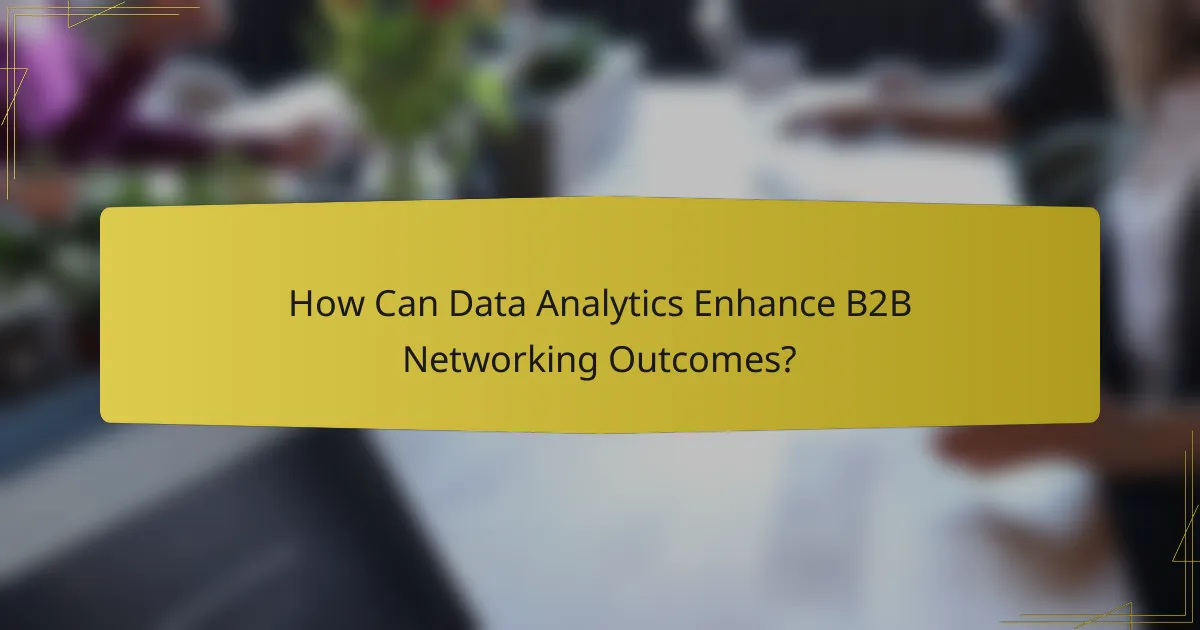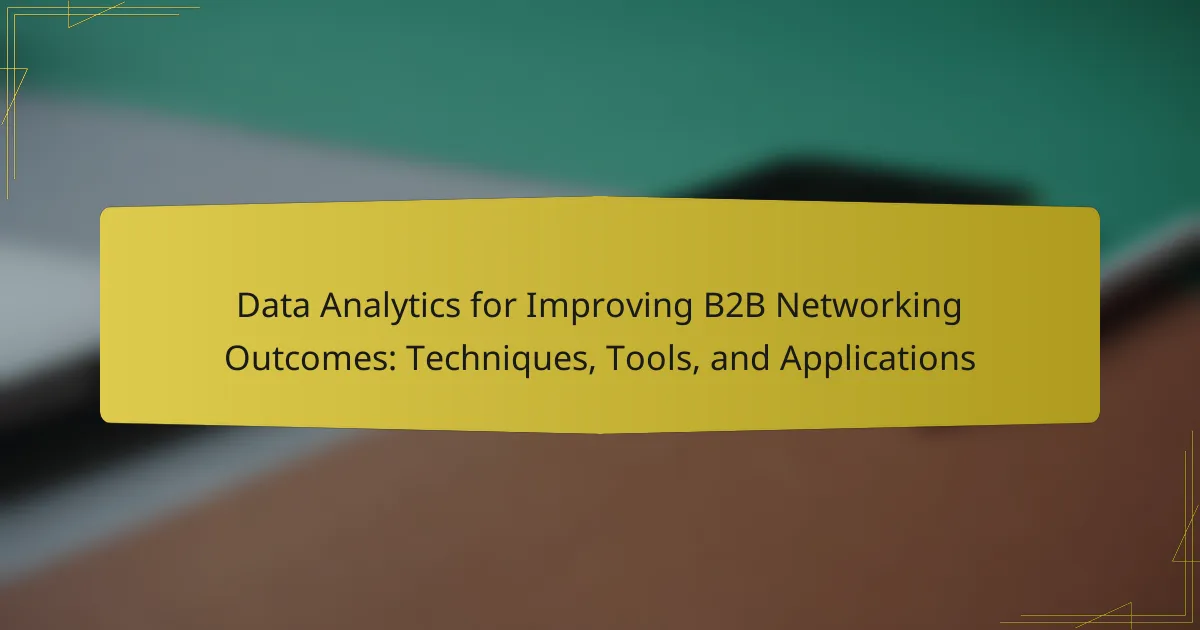Data analytics plays a crucial role in enhancing B2B networking outcomes by offering insights that facilitate informed decision-making and stronger relationship-building. By employing various analytical techniques and tools, businesses can effectively identify valuable leads, understand partner sentiments, and tailor their strategies to meet specific market needs.

How Can Data Analytics Enhance B2B Networking Outcomes?
Data analytics can significantly improve B2B networking outcomes by providing insights that drive better decision-making and relationship-building. By leveraging data, businesses can identify valuable leads, manage relationships more effectively, and tailor their marketing strategies to meet specific needs.
Improved lead generation
Data analytics enhances lead generation by analyzing customer behavior and identifying potential clients who are most likely to convert. By utilizing tools like CRM systems and data mining techniques, businesses can segment their audience based on demographics, interests, and past interactions.
For example, a company might use analytics to discover that a particular industry shows increased engagement with their content, allowing them to focus their outreach efforts on that sector. This targeted approach can lead to a higher conversion rate and more efficient use of resources.
Enhanced relationship management
Effective relationship management is crucial in B2B networking, and data analytics plays a key role in this area. By tracking interactions and analyzing feedback, businesses can gain insights into client satisfaction and preferences, enabling them to tailor their communication strategies.
For instance, using analytics tools, a company can identify which clients require more attention based on their engagement levels. This proactive approach can help in nurturing relationships, ultimately leading to increased loyalty and repeat business.
Data-driven decision making
Data-driven decision making involves using analytics to inform strategic choices, minimizing guesswork in business operations. By analyzing market trends and performance metrics, companies can make informed decisions about product development, pricing strategies, and resource allocation.
For example, a business might analyze sales data to determine which products are underperforming and adjust its marketing strategy accordingly. This approach not only enhances operational efficiency but also aligns offerings with market demand.
Increased event effectiveness
Data analytics can significantly boost the effectiveness of B2B events by providing insights into attendee preferences and behaviors. By analyzing past event data, businesses can tailor their agendas, marketing efforts, and networking opportunities to better meet the needs of participants.
For instance, tracking which sessions received the most engagement can help organizers plan future events that resonate with their audience. This data-driven approach can lead to higher attendance rates and improved participant satisfaction.
Targeted marketing strategies
Targeted marketing strategies are essential for maximizing the impact of marketing efforts, and data analytics enables businesses to create highly personalized campaigns. By analyzing customer data, companies can identify specific segments and craft messages that resonate with each group.
For example, a business might use analytics to determine that a segment of its audience responds well to email campaigns featuring case studies. By focusing on this approach, the company can enhance engagement and drive higher conversion rates.

What Techniques Are Effective for B2B Networking?
Effective techniques for B2B networking leverage data analytics to enhance connections and outcomes. By utilizing various analytical methods, businesses can identify opportunities, understand partner sentiments, and optimize their networking strategies.
Predictive analytics
Predictive analytics uses historical data to forecast future outcomes, making it a powerful tool for B2B networking. By analyzing trends and patterns, businesses can anticipate the needs of potential partners and tailor their outreach accordingly.
For example, a company might analyze past interactions to predict which clients are likely to engage in future collaborations. This approach can help prioritize leads and allocate resources effectively, increasing the chances of successful networking.
Sentiment analysis
Sentiment analysis evaluates the emotions behind communications, providing insights into how potential partners feel about a brand or industry. By analyzing social media posts, reviews, and other feedback, businesses can gauge public perception and adjust their networking strategies.
For instance, if sentiment analysis reveals negative feedback about a product, a company can address these concerns before reaching out to potential partners. This proactive approach can enhance credibility and foster stronger relationships.
Social network analysis
Social network analysis examines the relationships and interactions within a network, helping businesses identify key influencers and connections. By mapping out these relationships, companies can discover valuable networking opportunities and strategic partnerships.
For example, a firm might use social network analysis to find common connections with a target partner, facilitating introductions and enhancing trust. Understanding the dynamics of a network can lead to more effective engagement strategies.
Customer segmentation
Customer segmentation involves categorizing clients based on shared characteristics, allowing for more targeted networking efforts. By understanding different segments, businesses can tailor their messaging and approaches to resonate with specific groups.
For instance, a company might segment its audience by industry, size, or buying behavior, enabling more personalized outreach. This focused strategy can improve engagement rates and lead to more fruitful networking outcomes.

Which Tools Are Best for Data Analytics in B2B Networking?
Effective data analytics tools can significantly enhance B2B networking outcomes by providing insights into customer behavior, sales trends, and market opportunities. The right tools help businesses make informed decisions, optimize strategies, and foster valuable connections.
HubSpot
HubSpot is a comprehensive inbound marketing and sales platform that offers robust data analytics capabilities. It allows businesses to track customer interactions, analyze traffic sources, and measure campaign performance, all in one place.
Users can leverage HubSpot’s reporting tools to create custom dashboards that visualize key metrics, such as lead conversion rates and customer engagement levels. This helps in identifying successful strategies and areas needing improvement.
Salesforce
Salesforce is a leading customer relationship management (CRM) tool that excels in data analytics for B2B networking. It provides advanced analytics features, including customizable reports and dashboards that help track sales performance and customer relationships.
With Salesforce, businesses can analyze data trends over time, segment customers based on various criteria, and forecast sales opportunities. Its integration capabilities with other tools enhance data richness and usability.
LinkedIn Sales Navigator
LinkedIn Sales Navigator is a specialized tool designed for sales professionals to enhance B2B networking through data analytics. It offers advanced search filters and insights into potential leads, helping users identify and connect with the right prospects.
This tool provides real-time updates on leads and accounts, allowing users to tailor their outreach strategies. By leveraging LinkedIn’s vast network, businesses can gain valuable insights into industry trends and competitor activities.
Google Analytics
Google Analytics is a powerful web analytics tool that can be utilized for B2B networking by tracking website performance and user behavior. It helps businesses understand how visitors interact with their site, which can inform networking strategies and content marketing efforts.
Users can analyze traffic sources, user demographics, and conversion rates, enabling them to optimize their online presence. Setting up goals and events in Google Analytics allows businesses to measure specific actions that contribute to networking success.

What Metrics Should Be Tracked for Networking Success?
To measure networking success effectively, businesses should focus on key metrics that reflect engagement, conversion, and overall financial impact. Tracking these metrics helps identify strengths and weaknesses in networking strategies, enabling informed decision-making.
Engagement rates
Engagement rates indicate how actively participants interact within a networking context. This can include metrics such as the number of connections made, messages exchanged, or events attended. A higher engagement rate often correlates with stronger relationships and potential business opportunities.
To assess engagement, consider using tools that analyze social media interactions or event participation statistics. Aim for engagement rates above 20% in online platforms, as this suggests a healthy level of interest and activity.
Conversion rates
Conversion rates measure the percentage of networking interactions that lead to desired outcomes, such as new clients or partnerships. This metric is crucial for understanding the effectiveness of your networking efforts. A typical conversion rate in B2B networking might range from 5% to 15%, depending on the industry and approach.
To improve conversion rates, focus on nurturing relationships through follow-ups and personalized communication. Utilize CRM tools to track interactions and identify which strategies yield the highest conversions.
Customer acquisition cost
Customer acquisition cost (CAC) represents the total expense incurred to acquire a new customer through networking efforts. This includes marketing costs, event expenses, and any tools used for outreach. Keeping CAC low is essential for maintaining profitability.
To calculate CAC, divide total networking expenses by the number of new customers acquired. Aim for a CAC that is significantly lower than the lifetime value of a customer (LTV), ideally maintaining a ratio of 1:3 or better.
Return on investment
Return on investment (ROI) measures the profitability of networking initiatives relative to their costs. A positive ROI indicates that the benefits gained from networking exceed the expenses incurred. In B2B contexts, a good ROI target is often around 30% or higher.
To calculate ROI, subtract the total costs from the total revenue generated through networking, then divide by the total costs. Regularly reviewing ROI helps refine networking strategies and allocate resources more effectively.

How to Choose the Right Data Analytics Tools?
Selecting the right data analytics tools is crucial for enhancing B2B networking outcomes. Consider your specific needs, the types of data you will analyze, and the integration capabilities with existing systems.
Identify Your Business Needs
Start by assessing your business objectives and the specific analytics requirements. Determine whether you need tools for data visualization, predictive analytics, or real-time reporting. Prioritize features that align with your goals, such as user-friendliness or advanced statistical capabilities.
For example, if your focus is on understanding customer behavior, tools with strong customer segmentation features will be essential. Conversely, if you need to monitor sales performance, look for tools that offer robust reporting functionalities.
Evaluate Integration Capabilities
Ensure that the analytics tools can seamlessly integrate with your existing systems, such as CRM or ERP platforms. Compatibility will save time and reduce data silos, allowing for a more comprehensive analysis.
Check if the tools support APIs or have pre-built connectors for popular platforms. This will facilitate smoother data flow and enhance your overall analytics capabilities.
Consider Scalability and Support
Choose tools that can grow with your business. Scalability is vital, especially if you anticipate an increase in data volume or user numbers. Look for solutions that offer tiered pricing plans or modular features that can be added as needed.
Additionally, consider the level of customer support provided. Reliable support can significantly impact your ability to troubleshoot issues and maximize the tool’s potential.
Assess Cost and ROI
Analyze the total cost of ownership, including subscription fees, implementation costs, and training expenses. Compare these costs against the expected return on investment (ROI) from improved decision-making and operational efficiencies.
Utilize free trials or demo versions to gauge the tool’s effectiveness before committing financially. This hands-on experience can provide valuable insights into its usability and fit for your organization.
